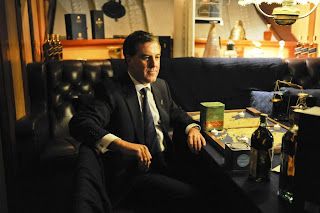 |
| The James Craig moored in Pyrmont. Ship built in 1874. |
So it was with no small amount of scepticism that I attended last week's Johnnie Walker Blue Label new packaging launch. To be fair it was the promise of free mid-day Scotch that go it across the line - that and the fact that the event was on a boat moored only minutes away from Booze Braggart HQ.
Excellent canapés, mighty fine drinks, and superlative company aside this relaunch was successful in my mind due to the re-telling of one of Scotch whisky's most fascinating stories - the Walker story. It's a tale told admirably here by Robert Carlyle:
Whilst Mr Carlyle was unable to attend this particular launch we were lucky enough to have Jonathan Driver - Johnnie Walker's global brand ambassador - on hand to take us through the brand's history and the thinking behind its new look.
 |
| Jonathan Driver, Johnnie Walker's global brand ambassador |
John Walker - a young farmer's boy was left a modest inheritance from his father. It was enough however for the lad to open a grocers store in Kilmarnock that purveyed products from the four corners of the world - rum from Virginia, tea from China and spices from India and the Caribbean. In the 1820s it was tea that was the luxury drink of the day and as such John Walker and his sons practised the art of tea blending before that of whisky. It just so happens, however, that flavour profiles for tea and whisky are almost identical- a point well demonstrated by the smoky lapsang souchong tea placed in front of us by Driver. "Tea is the DNA for Johnnie Walker's whiskies," driver tells us. "We learnt from tea how to make whisky."
"Tea is the DNA for Johnnie Walker's whiskies. We learnt from tea how to make whisky." -Jonathan Driver, Johnnie Walker's global brand ambassador.
The Blue Label itself is based on the 1867 Old Highland Cask blended by John Walker's son Alexander. Blue Label, whilst not a replica, is a form of liquid archaeology - a robust blend, inspired by tea of all things, to be reminiscent of the whisky that the Walkers began shipping around the world during the second half of the 19th century
Sitting below deck on the James Craig - a restored 1874 squared rigged trading vessel - Driver finally explains what we're doing on an antiquarian ship. You see the Walkers weren't content with just being a success domestically but wanted to spread to the four corners of the world where their grocery products came from. They convinced ship captains to do the work for them and one of the whisky's first stops was Sydney - perhaps even the James Craig itself bore a cargo of the Walker's Old Highland Cask to Australia. At any rate the whisky established itself in the colony quickly - becoming the New South Wales leading whisky brand by 1889.
 |
| The new look Johnnie Walker Blue Label |
And what's inside the bottle? Well it's the same smart dram as always- a nose of orange citrus and dried apricot with a black tea complexity gives way to a buttery, toffee-like and mouth-filling palate. A rich textural finish that yields subtle warming smoke. In short, eminently quaffable.
